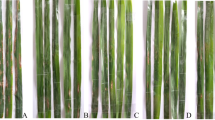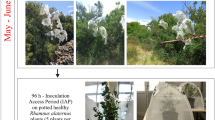Abstract
We evaluated, in a laboratory experiment, the susceptibility of 10 tomato cultivars to the attack by the tomato red spider mite Tetranychus evansi, an invasive pest of this crop in Benin. Among the 10 cultivars tested, six were imported (i.e. Roma VF, Tima, Rio Grande, Buffalo, Petomech, and TLCV15) and four local (i.e. Akikon, Tounvi, TomL4, and Kèkèfo). Leaf disks (2.5 cm diameter) excised from leaves of tested cultivars, and placed upper side down on top of water-soaked cotton wool laying in 9.5 cm diameter Petri dishes (6 leaf disks per Petri dish), served both as experimental units and feeding source for the mites. Mites were individually placed on leaf disks of each cultivar and several biological parameters – development, reproductive parameters and longevity – were assessed. The experiments were performed at 27 ± 1 °C, 65–70% RH, and 12:12 h (L: D) photoperiod. Our results revealed significant effects of tomato cultivars on several biological parameters of T. evansi, especially the developmental time of the egg stage (P ˂ 0.0001), and the larval stage (P = 0.0113), as well as female oviposition period (P = 0.0002). Likewise, female longevity (P = 0.0095) and fecundity (i.e. egg/♀, P = 0.0055) were significantly affected. The sex-ratio of the progeny was generally similar for all the cultivars except for Buffalo and Tounvi on which most juveniles did not develop beyond the larval stage. These two cultivars appeared as potential tomato cultivars for implementation of IPM strategies for the control of T. evansi.


Similar content being viewed by others
References
Adkisson PL, Dyck VA (1980) Resistant varieties in pest management systems. In: Breeding Plants Resistant to Insects (edited by Maxwell, F.G. and Jennings, P.R.), pp. 233–251
Alba JM, Schimmel BCJ, Glas JJ, Ataide LMS, Pappas ML, Villarroel CA, Schuurink RC, Sabelis MW, Kant MR (2015) Spider mites suppress tomato defenses downstream of jasmonate and salicylate independently of hormonal crosstalk. New Phytol 205:828–840
André HM, Remacle CL (1984) Comparative and functional morphology of the gnathosoma of Tetranychus urticae (Acari: Tetranychidae). Acarologia 25:179–190
Azandémè-Hounmalon GY, Fellous S, Kreiter S, Fiaboe KKM, Subramanian S, Kungu M, Martin T (2014) Dispersal behavior of Tetranychus evansi and T. urticae on tomato at several spatial scales and densities: implications for integrated Pest management. PLoS One 9(4):e95071. https://doi.org/10.1371/journal.pone.0095071
Azandémè-Hounmalon GY, Affognon HD, Assogba-Komlan F, Tamó M, Fiaboe KKM, Kreiter S, Martin T (2015) Farmer’s control practices against the invasive red spider mite, Tetranychus evansi Baker & Pritchard in Benin. Crop Prot 76:53–58
Boubou A, Migeon A, Roderick G, Navajas M (2011) Recent emergence and worldwide spread of the red tomato spider mite, Tetranychus evansi: genetic variation and multiple cryptic invasions. Biol Invasions 13:81–92
Chatzivasileiadis EA, Sabelis MW (1997) Toxicity of methyl ketones from tomato trichomes to Tetranychus urticae Koch. Exp Appl Acarol 21:473–484
Duverney C, Gueye-Ndiaye A (2005) Essais préliminaires pour limiter les dégâts de Tetranychidae sur les cultures maraichères dans le Sine-Saloum (Sénégal). In : Comptes rendus de deuxième colloque international sur les acariens des cultures de l’AFPP. Agro-Montpellier (France), 24–25 octobre. Annales AFPP, 80p
Escudero LA, Ferragut F (1999) Tetranychus evansi Baker & Pritchard (Acari, Tetranychidae), una nueva araña roja en los cultivos hortícolas españoles. Bol Sanid Veg Plagas 25:157–164
FAOSTAT (2012) Importance de la production de tomate dans les pays ACP en 2008-2009
Furtado IP, Moraes GJ, Kreiter S, Tixier M, Knapp M (2007) Potential of a Brazilian population of the predatory mite Phytoseiulus longipes as a biological control agent of Tetranychus evansi (Acari: Phytoseiidae, Tetranychidae). Biol Control 42:139–147
Gonçalves LD, Maluf WR, Cardoso MG, Resende JTV, Castro EM, Santos NM, Nascimento IR, Faria MV (2006) Relação entre zingibereno, tricomas foliares e repelência de tomateiros a Tetranychus evansi. Pesq Agrop Brasileira 41:267–273
Handley R, Ekbom B, Agren J (2005) Variation in trichome density and resistance against a specialist insect herbivore in natural populations of Arabidopsis thaliana. Ecol Entomol 30:284–292
Helle W, Sabelis MW (1985) Spider mites. Their biology, natural enemies and control 1 a. Elsevier Science Publishing Company B.V, Amsterdam, 405p
Kennedy GG (2003) Tomato, pests, parasitoids, and predators: tritrophic interactions involving the genus Lycopersicon. Annu Rev Entomol 48:51–72
Luckwill LC (1943) The genus Lycopersicon: an historical, biological and taxonomic survey of the wild and cultivated tomatoes. Aberdeen Univ Stud 120:1–44
Maluf WR, Campos GA, Cardoso MG (2001) Relationships between trichome types and spider mites (Tetranychus evansi) repellence in tomatoes with respect to foliar zingiberene contents. Euphytica 121:73–80
Maniania NK, Bugeme DM, Wekesa VW, Delalibera I Jr, Knapp M (2008) Role of entomopathogenic fungi in the control of Tetranychus evansi and Tetranychus urticae (Acari: Tetranychidae), pests of horticultural crops. Exp Appl Acarol 46:259–274
Martin T, Assogba-Komlan F, Sidick I, Ahle V, Chandre F (2010) An acaricide-treated net to control phytophagous mites. Crop Prot 29:470–475
Migeon A, Ferragut F, Escudero-Colomar L, Fiaboe K, Knapp M, de Moraes G, Ueckermann E, Navajas M (2009) Modelling the potential distribution of the invasive tomato red spider mite, Tetranychus evansi (Acari: Tetranychidae). Exp Appl Acarol 48:199–212
Migeon A, Auger P, Navajas M (2014) Dynamique des invasions biologiques : routes de colonisation et modélisation de l'expansion chez Tetranychus evansi. AFPP – Colloque ravageurs et insectes invasifs et émergents Montpellier – 21 octobre 2014. 11p
Murungi LK, Knapp M, Masinde PW, Onyambu G, Gitonga L, Agong SG (2009) Host-plant acceptance, fecundity and longevity of Tetranychus evansi (Acari: Tetranychidae) on selected tomato accessions. Afr J Hortic Sci 2:79–91
Murungi LK, Nyende AB, Wesonga JM, Masinde PW, Knapp M (2010) Effects of different African nightshade species on developmental time and life table parameters of Tetranychus evansi (Acari: Tetranychidae). Exp Appl Acarol 52:19–27
Murungi LK, Kirwa H, Torto B (2013) Within-plant variation in essential oil composition of Solanum sarrachoides and its effects on oviposition of the tomato spider mite (Tetranychus evansi). Ind Crop Prod 46:73–79
Onyambus GK, Maranga RO, Gitonga LM, Knapp M (2011) Host plant resistance among tomato accessions to the spider mite Tetranychus evansi in Kenya. Exp Appl Acarol 54:385–393
Resende JTV, Maluf WR, Cardoso MG, Nelson DL, Faria MV (2002) Inheritance of acylsugar contents in tomatoes derived from interspecific crosses with wild tomato Lycopersicon pennellii and their effect on spider mite repellence. Genet Mol Res 1:106–116
Resende JTD, de Maluf WR, Cardoso MG, Faria MV, Gonçalves LD, Nascimento do I. R. (2008) Resistance of tomato genotypes with high level of acyl sugars to Tetranychus evansi Baker & Pritchard. Sci Agric 65(1):31–35
Saunyama IGM, Knapp M (2003) Effect of pruning and trellising of tomatoes on red spider mite incidence and crop yield in Zimbabwe. Afr Crop Sci J 11:269–277
Simmons AT, Gurr GM (2005) Trichomes of Lycopersicon species and their hybrids: effects on pests and natural enemies. Agric For Entomol 7:265–276
Simmons AT, Gurr GM, McGrath D, Nicol HI, Martin PM (2003) Trichomes of Lycopersicon spp. and their effect on Myzus persicae (Sulzer) (Hemiptera: Aphididae). Aust J Entomol 42:373–378
Snyder JC, Carter CD (1985) Trichomes on leaves of Lycopersicon hursutum, L esculentum and their hybrids. Euphytica 34:53–62
Tindo M, Tamo M (1999) Fruit fly (Dacus punctatifrons:Diptera, Tephritidae) as tomato pest in Lekié (southern-Cameroon). Ann Soc Entomol Fr 35:525–527
Tomczyk A, Kropczynska D (1985) Effects on the host plant. In: Helle W, Sabelis MW (eds) Spider mites, their biology, natural enemies and control, vol I A. Elsevier, Amsterdam, pp 317–329
Valverde PL, Fornoni J, Nunez-Farfan J (2001) Defensive role of leaf trichomes in resistance to herbivorous insects in Datura stramonium (Solanaceae). J Evol Biol 14:424–432
Wekesa VW, Maniania NK, Knapp M, Boga HI (2005) Pathogenicity of Beauveria bassiana and Metarhizium anisopliae to the tobacco spider mite Tetranychus evansi. Exp Appl Acarol 36:41–50
Weston PA, Johnson DA, Burton HT, Snyder JC (1989) Trichome secretion composition, trichome densities and spider mite resistance of ten accessions of Lycopersicon hirsutum. J Am Soc Hortic Sci 114:492–498
Acknowledgements
This study was funded by International Institute of Tropical Agriculture (IITA). The authors are thankful to Richard Houndafoché and Pierre Sovimi for their technical assistance. We are grateful to Dr. Muaka Toko, for providing valuable comments on earlier versions of the manuscript. We also thank an anonymous reviewer whose suggestions significantly improved the manuscript.
Author information
Authors and Affiliations
Corresponding author
Ethics declarations
Conflict of interest
The author declare that they have no conflict of interest.
Additional information
Publisher’s note
Springer Nature remains neutral with regard to jurisdictional claims in published maps and institutional affiliations.
Rights and permissions
About this article
Cite this article
Djossou, R., Azandémè-Hounmalon, G.Y., Onzo, A. et al. Susceptibility of ten tomato cultivars to attack by Tetranychus evansi Baker & Pritchard (Acari: Tetranychidae) under laboratory conditions. Int J Trop Insect Sci 41, 425–431 (2021). https://doi.org/10.1007/s42690-020-00221-9
Received:
Accepted:
Published:
Issue Date:
DOI: https://doi.org/10.1007/s42690-020-00221-9




